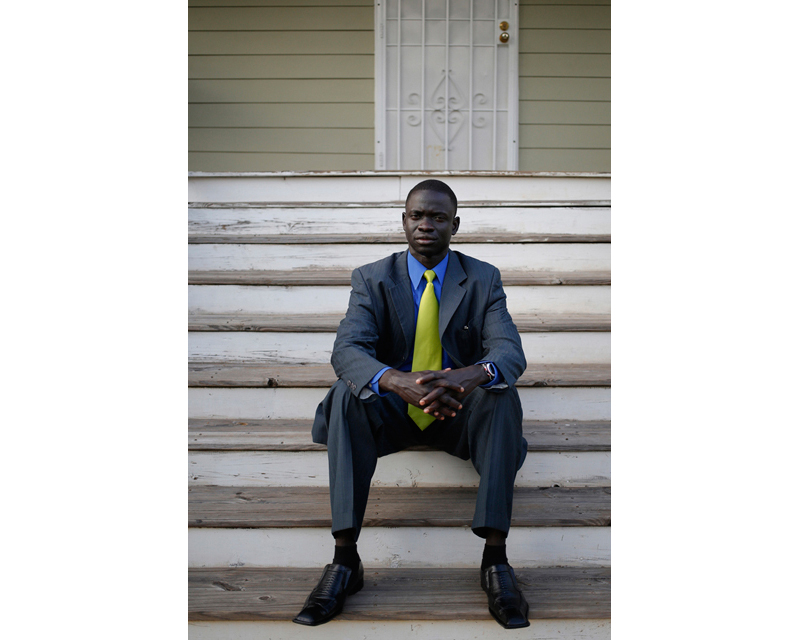Sunday, December 29, 2013
Kentucky's Leaves of Gold

Read more...
Saturday, December 28, 2013
The Lost Boys - Jacob Mach

Read more...
Wednesday, December 25, 2013
Coming Home - Fort Knox
Last month I covered the return of 250 soldiers from Afghanistan to Fort Knox, Ky. for Getty Images. Troop returns are a lot of fun to photograph, though capturing the fleeting moments and gathering accurate caption information can be hectic and stressful as a photojournalist. There's something about seeing soldiers return from war and reunite with their families that resonates deeply inside me. Witnessing so many joyous reunions in a short period of time often causes tears of my own to well up and block my viewfinder. Still, I feel a tinge of sadness in my heart as I long for the reunion I never had with my cousin, Pfc. David H. Sharrett. Welcome home, troops.

Rachel Wolfston and her 2-year-old daughter Alexia wait to greet Spc. Joshua Wilson of the U.S. Army's 3rd Brigade Combat Team, 1st Infantry Division, during a homecoming ceremony in the Natcher Physical Fitness Center on Fort Knox in the early morning hours of Wednesday, November 20, 2013 in Fort Knox, Ky. About 250 soldiers from 3rd Brigade returned to Fort Knox after a nine-month combat deployment working alongside Afghan military and police forces in Afghanistan's Zabul Province. (Photo by Luke Sharrett/Getty Images)
Read more...
Monday, December 23, 2013
Mike Yastrzemski for The New York Times
Earlier this year I photographed Vanderbilt University right fielder Mike Yastrzemski (#18) in Nashville before a home game. Mike (grandson of famous Boston Red Sox player Carl Yastrzemski) has been a standout player for Vandy for the last couple years and has good MLB draft prospects. Mike was great to shoot and really seemed like a pillar of the team. For more on Mike and the baseball heritage of the Yastrzemski family check out the story by Tyler Kepner of The New York Times here.

Read more...
Sunday, December 22, 2013
Route 66
Last week I drove 125 miles of historic Route 66 between Williams and Holbrook, Arizona. Retracing what's left of "The Mother Road," the iconic 2400 mile highway that stretches from Chicago to Los Angeles, was a mixed bag of emotions. By the mid-eighties nearly all of the towns along Route 66 in Arizona had been bypassed by Interstate 40. Many of the bypassed towns have withered severely over the years. I only had a few hours this trip, but I could spend a week on Route 66 in Arizona alone. The road is rich with history and stories of a bygone era. Many great photographers have captured this strip of road in the past, but here's my humble contribution to telling the story of America's highway. Thanks are due to my dear wife for graciously letting me take a day of our vacation to shoot these photos.

Read more...
Monday, November 18, 2013
Veterans Day 2013
I found myself back at Arlington National Cemetery this Veterans Day thanks to a cheap plane ticket and hospitable friends. Despite being a holiday devoted to living veterans, past and present, a few Americans also make their way to Section 60 to honor fallen comrades, friends, and family members. Below are a few frames from an ongoing series: Gardens of Stone.
Read more...
Saturday, September 7, 2013
The 139th Kentucky Derby
The Kentucky Derby is without a doubt one of the most unique and exciting annual traditions of any state in the Union. The beauty of the champion thoroughbreds, the elegance of Churchill Downs, and the pomp and circumstance of seersucker suited men and derby hatted women combine to make the first Saturday in May a truly timeless event. Few things give me goosebumps quite like hearing the entire grandstand sing the state anthem "My Old Kentucky Home." Nor does any sound quite spike my heart rate as the thunderous hoof beats of the pack rounding the first turn. Every Derby is different, and this one was no exception. A steady, soaking rain fell throughout most of the afternoon, creating a sloppy track for the big race. Crowd favorite Orb crossed the finish line in first to clinch the most prestigious single race title in racing: Kentucky Derby champion.
Race horses complete their morning workouts at Churchill Downs in Louisville, Ky. on the morning of the 139th running of The Kentucky Derby on Saturday, May 4, 2013. Luke Sharrett for The New York Times
Read more...
Wednesday, July 24, 2013
Old News
Here are some photos from Washington, DC after last year's election. Seeing as it took me 7 months to decide whether or not to blog them, I was hesitant to post them. They're no longer newsworthy, but hopefully these photos are good for something.
Campaign signs were placed outside a polling place at Hanover County Fire Dept. Station 4 in Doswell, Va. on election day, Tuesday, November 6, 2012. Luke Sharrett for The New York Times
Read more...
Thursday, July 4, 2013
Walking Wounded

Tori Smith pushes her husband, Spc. Andrew Smith, through a parking garage at Walter Reed National Military Medical Center in Bethesda, Md. after his morning physical therapy session on Monday, October 22, 2012. Smith was severely wounded in an improvised explosive device (IED) attack in Afghanistan on March 8, 2012 during his first deployment with the 82nd Airborne Division. Luke Sharrett for World Magazine.
Read more...
Sunday, June 16, 2013
Gardens of Stone - Arlington National Cemetery
Every Memorial Day scores of mourners make an annual pilgrimage to Section 60 of Arlington National Cemetery. Located in the Southeast corner of Arlington's sprawling hallowed ground, this ever-growing plot of land is home to much of America's war dead from recent conflicts in Iraq, Afghanistan, and the Global War on Terror. Section 60 is home to service members from all five branches of the military: Army, Navy, Air Force, Marines, and Coast Guard. Family members, friends, and complete strangers travel from around the country to stroll through the sea of white headstones, paying respects, reading names, placing flowers, and leaving behind mementos atop the graven white marble monuments. Throughout the year meaningful items are left atop and around the headstones of fallen military personnel, usually on birthdays or death anniversaries. In the days following Memorial Day and Veterans Day however, the number of mementos left behind grows substantially. From unit insignia, shell casings, roses, and challenge coins, to alcohol, candy bars, and childhood action figures, the items that adorn the headstones often tell a story that the headstone alone cannot.
Read more...
Wednesday, January 30, 2013
In the crosshairs: Gun Control
While walking through the Mass Media and Technology Hall at Western Kentucky University this afternoon a large 4 screen television bank broadcasting CNN caught my attention. There in the unintentional crosshairs formed by the 4 flat screen samsung TV's was the author of the 1994 Federal Assault Weapons Ban Senator Dianne Feinstein (D-Calif.) and her apparent foil Wayne LaPierre, CEO of the National Rifle Association. Shot with an iPhone 5.

Read more...
Monday, January 28, 2013
The 57th Inauguration
The big day started with a 4am wake up call. Because I was assigned to be in the White House travel pool on Inauguration Day, I got to sleep in. My co-workers at the New York Times had to be at the U.S. Capitol by four, thus dictating an even earlier wake up call. This was my first inauguration "inside the bubble," but not my first altogether. In 2008 I road-tripped from Western Kentucky with friends and classmates from my photojournalism classes to cover President Barack Obama's first inauguration. We awoke long before the crack of dawn and stuffed ourselves into overloaded subway cars like sardines. By the time we got to the National Mall we couldn't get any closer to the Capitol than the Washington Monument.

Read more...




